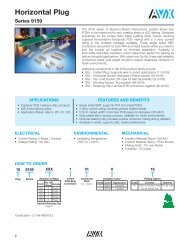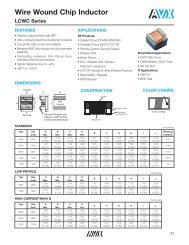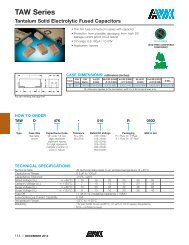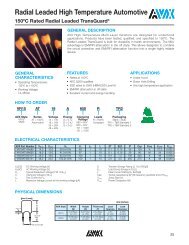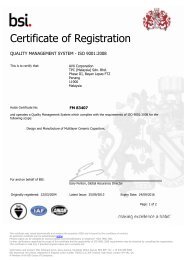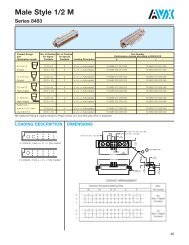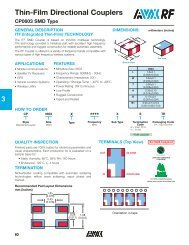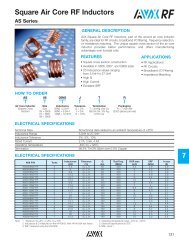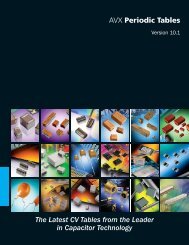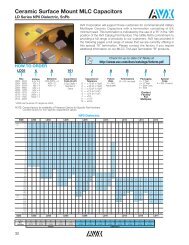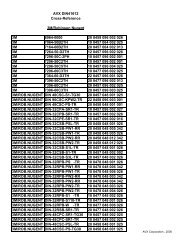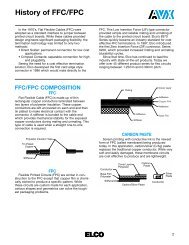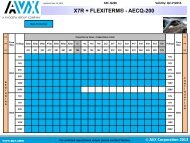X5R Dielectric LD Series Tin/Lead Terminations - AVX
X5R Dielectric LD Series Tin/Lead Terminations - AVX
X5R Dielectric LD Series Tin/Lead Terminations - AVX
Create successful ePaper yourself
Turn your PDF publications into a flip-book with our unique Google optimized e-Paper software.
Medium Power Film Capacitors<br />
FFB (RoHS Compliant)<br />
The FFB series uses a non-impregnated metallized polypropylene<br />
or polyester dielectric with the controlled<br />
self-healing process, specially treated to have a very high<br />
dielectric strength in operating conditions up to 105°C.<br />
The FFB has been designed for printed circuit board mounting.<br />
Its performance allows the FFB to be a very interesting alternative<br />
to electrolytic technology as it can withstand much higher<br />
levels of surge voltage.<br />
APPLICATIONS<br />
The FFB capacitor is particularly designed for DC filtering, low<br />
reactive power.<br />
HOT SPOT CALCULATION<br />
See Hot Spot Temperature, page 3.<br />
Check for up-to-date CV Tables at<br />
http://www.avx.com/docs/catalogs/filmcaps.pdf<br />
PACKAGING MATERIAL<br />
Self-extinguishing plastic case (V0 = in accordance with UL 94)<br />
filled thermosetting resin.<br />
Self-extinguishing thermosetting resin (V0 = in accordance with UL<br />
94; I3F2 = in accordance with NF F 16-101).<br />
STANDARDS<br />
IEC 61071-1, IEC 61071-2: Power electronic capacitors<br />
IEC 60384-16: Fixed metallized polypropylene<br />
film dielectric DC capacitors<br />
IEC 60384-16-1: Fixed metallized polypropylene<br />
film dielectric DC capacitors<br />
Assessment level E<br />
IEC 60384-17: Fixed metallized polypropylene<br />
film dielectric AC and pulse<br />
capacitors<br />
IEC 60384-17-1: Fixed metallized polypropylene<br />
film dielectric AC and pulse<br />
capacitors<br />
Assessment level E<br />
IEC 60384-2: Fixed metallized polyester capacitors<br />
θ hot spot = θ ambient + (P d + P t ) x R th<br />
with P d (<strong>Dielectric</strong> losses) = Q x tgδ 0<br />
Q x tgδ 0 ⇒ [ 1 ⁄2 x C n x (V peak to peak ) 2 x f ] x tgδ 0<br />
tgδ 0 (tan delta)<br />
For polypropylene, tgδ 0 = 2 x 10 -4 for frequencies<br />
up to 1MHz and is independent of temperatures.<br />
For polyester, tgδ 0 values are shown in graph 4 on<br />
page 3.<br />
P t (Thermal losses) = R s x (I rms ) 2<br />
where C n in Farad I rms in Ampere f in Hertz<br />
V in Volt R s in Ohm θ in °C<br />
R th in °C/W<br />
WORKING TEMPERATURE<br />
(according to the power to be dissipated) -55°C to +105°C<br />
LIFETIME EXPECTANCY<br />
One unique feature of this technology (as opposed to electrolytics)<br />
is how the capacitor reacts at the end of its lifetime. Unlike<br />
aluminum, electrolytic film capacitors do not have a catastrophic<br />
failure mode. Film capacitors simply experience a parametric<br />
loss of capacitance of about 2%, with no risk of short circuit.<br />
Please note that this is theoretical, however, as the capacitor<br />
continues to be functional even after this 2% decrease.<br />
HOW TO ORDER<br />
FFB 1 4<br />
D<br />
0336<br />
K<br />
––<br />
<strong>Series</strong><br />
Case<br />
Size<br />
1<br />
2<br />
3<br />
4<br />
5<br />
<strong>Dielectric</strong><br />
4 = Polyester<br />
6 = Polypropylene<br />
Voltage<br />
Code<br />
D = 75Vdc<br />
E = 100Vdc<br />
H = 300Vdc<br />
I = 400Vdc<br />
J = 525Vdc<br />
A = 720Vdc<br />
C = 900Vdc<br />
L = 1100Vdc<br />
Capacitance<br />
Code<br />
0 + pF code<br />
0336 = 33μF<br />
0686 = 68μF<br />
0117 = 110μF<br />
etc.<br />
Capacitance<br />
Tolerances<br />
K = ±10%<br />
<strong>Lead</strong> Styles<br />
– – = 2 <strong>Lead</strong>ed<br />
JC = 4 <strong>Lead</strong>ed<br />
Consult Factory<br />
for Special<br />
Options<br />
LEAD-FREE COMPATIBLE<br />
COMPONENT<br />
www.avx.com | 163



